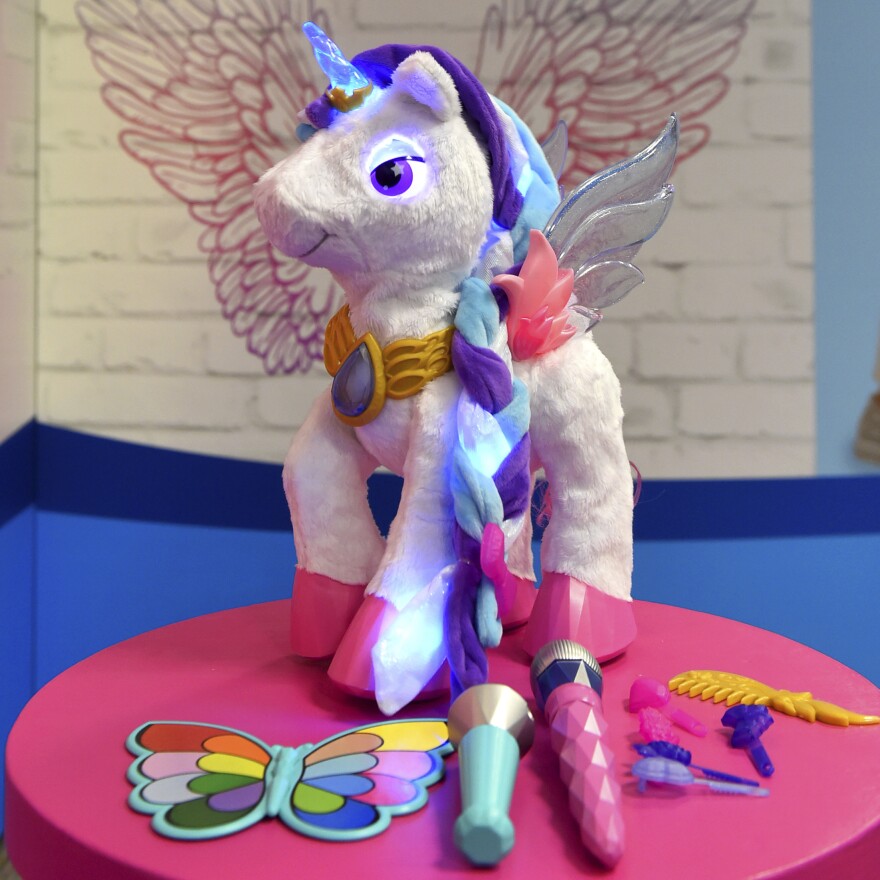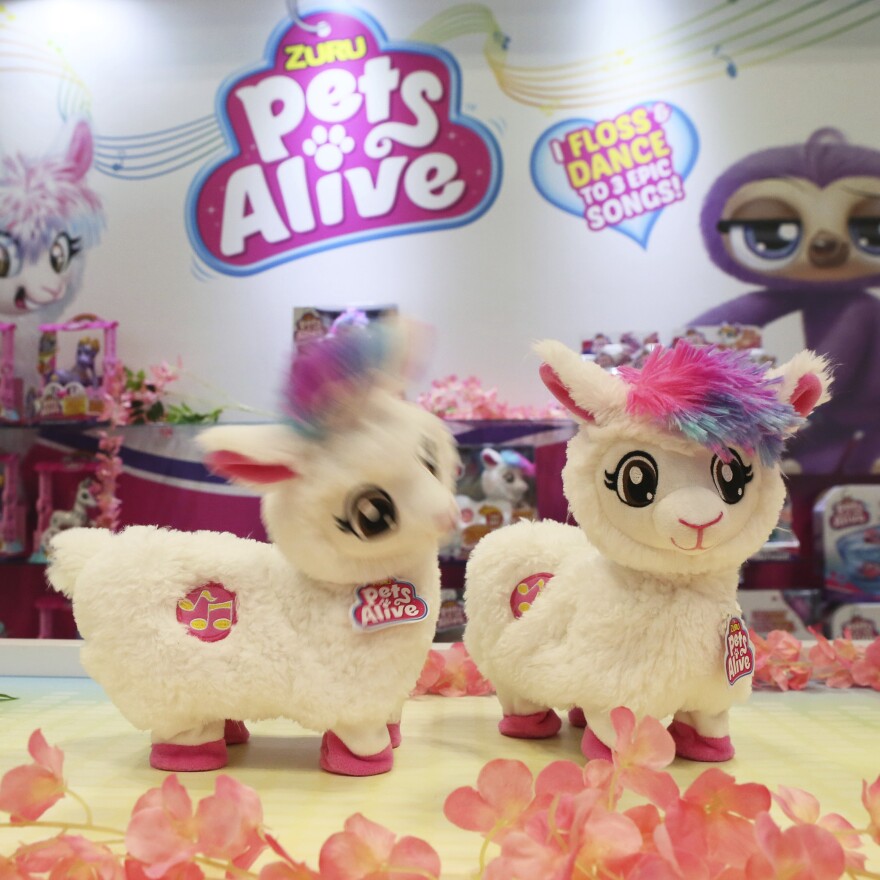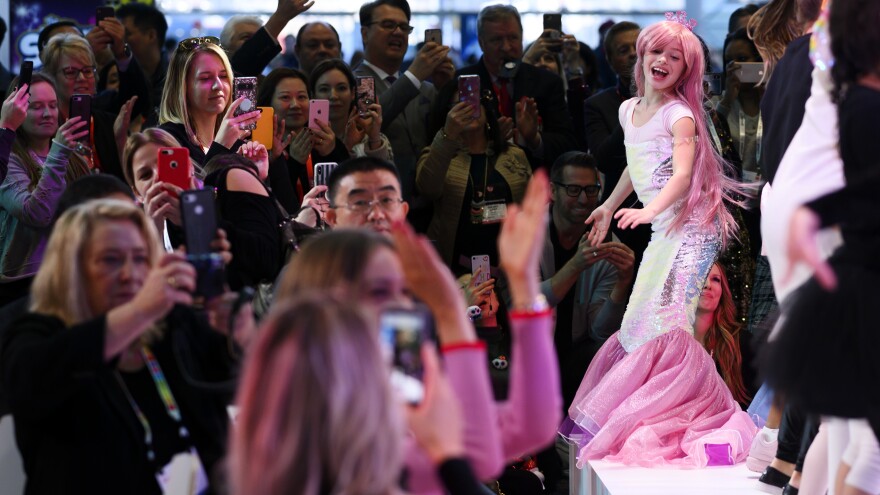With Rainbow Butterfly Unicorn Kitty on one side and bulbous-headed Fart Ninjas on the other, the gender divide was impossible to avoid at the North American International Toy Fair in New York City back in February.
The light-up Barbie mermaids vying for space with Gatling-style foam-dart blasters in Manhattan's Javits Center raised a question: Have toys really progressed since our grandparents' days? And how do the toys we play with shape the people we grow up to be?
We set out to answer these and related questions in our latest episode of Life Kit's podcast Parenting: Difficult Conversations, with help from Sesame Workshop.
Toys are getting more gendered
Researcher Elizabeth Sweet studied toy catalogs and ads over time and found that toys are actually more gender divided than they were half a century ago.
Rebecca Hains, a professor at Salem State University in Massachusetts, has written a book about it: The Princess Problem : Guiding Our Girls Through The Princess-Obsessed Years.
Disney characters, she points out, used to be more diverse: There was Cinderella, sure, but also Pinocchio and Bambi. When 1989's The Little Mermaidmade a splash, Hains says, "Disney realized profitability in girls." Enter the juggernaut Disney Princess brand. Plus, marketers now cloak even gender-neutral toys like blocks in both primary and pastel shades in the hope of selling more sets.

Even with several women vying to be the United States' next president, and even with a greater awareness of the spectrum of gender identity than we've ever had in our culture, Hains says, "it's almost like kids are subject to stereotypes that we've evolved out of elsewhere."
And these stereotypes can stick.
In a 2013 study of undergraduate women, one-third identified themselves as "princesses." They placed a higher value on the physical attractiveness of a mate, were less likely to want to join the workforce after college and were more likely to say they wanted to marry a breadwinner. And when all the women were given puzzles to solve, the "princesses" quit faster.
(This study, a conference paper, is described and cited in this paper, co-authored by Sarah Coyne, which similarly showed that girls who preferred playing princesses showed more gender-stereotyped behavior a full year later.)
Researchers haven't proved that all little girls who like tutus will grow up to be entitled quitters. But play does prepare children for life, so boys and girls both need broad options, says Rosemarie Truglio, a developmental psychologist and vice president of education and research for Sesame Workshop.
"It's OK for me to like pink things and pretty things and frilly things, but it shouldn't define who I am and shouldn't define what I will be in the future," Truglio says. "Anyone who is singly defined doesn't make a really interesting person."
Here are our takeaways for how to handle toy problems.
1. Bans will backfire — no pun intended.

You can certainly outlaw a toy that makes you uncomfortable, but consider this:
"I don't think banning anything is the answer," Truglio says. She found this out the hard way as a mom herself. At first "we had the rule: No [toy] guns in our home," she says. But she realized that all her young son's friends were playing with them, typically in the hallway of their apartment building.
Group play and the friendship that comes with it are so important for kids, Truglio believes, that she decided to allow the toy gun, with conditions. Besides, if you say no, the odds are that the toy will become even more coveted, she says.
2. How they play is more important than what they play with.
No toy is inherently good or wicked, says Lisa Dinella, a gender studies professor at Monmouth University and co-author of the aforementioned 2013 princess study. With a gun, "you can be really, really aggressive, or you can just be shooting targets." Equally, a princess game could be all about being pretty, or it could have a sophisticated plot.
One red flag, Truglio says, is when there's no variety to a child's play. For example, if your child wants to play with only toy guns, and the play is always aggressive, then that could be a sign for you, as a parent, to step in and find out what's really troubling the child.
3. Parents can counter sexist messages.
Dinella says kids start learning gender stereotypes before they're out of diapers. "Between 18 months and 2 years is the first time we're starting to see their awareness."
They learn by watching us. Studies show that parents perceive newborn girls as more delicate and newborn boys as being stronger. On the playground, mothers intervene with girls, seeing physical risks, more often.
"So it's really hard to separate out toy preference from gender socialization that is so insidious," Hains says.

Dinella has done several experiments on how heavy gender branding influences kids' toy choices. In one, she and her team painted a bunch of toys white. Without color cues, both boys and girls gravitated toward neutral playthings like Play-Doh and the Etch A Sketch.
In another experiment, titled "Pink Gives Girls Permission," Dinella and her co-authors flipped the traditional color patterns: pink trucks and camouflage-clad baby dolls. She found that "there's a bigger barrier to boys playing with girl things and acting like girls than for girls to be able to venture into some of these cross-gender plays."
Dinella says you can see this inequity in how hard our culture still comes down on the little boys who love princesses and sparkly things.
This is too bad, she says, because toys can teach important and sometimes unexpected skills. Dolls prepare boys for future roles as fathers and help them practice empathy. Acting out a tea party can help children learn "cognitive sequencing of events: the beginning, the middle and the end of a task." In other words, a tea set can introduce one of the foundations of computer coding.
So Dinella suggests that, when toy shopping, strive for gender balanced as well as gender neutral. Try saying something like, "You have four dolls already, so how about ... also getting a truck?"
Or, "Can we get it in the white version so that all of the kids, when they come to our house, can play with it, instead of just the pink version?"
4. Talk to your kids directly, and share your values around toys.

Dinella is also a mother, and she didn't ban toy guns either. But she does let her children know that she's not wild about them. "I'm never going to say, 'Hey, we haven't played with the Nerf guns a lot lately! Let's get those out!' "
In other cases, she says, you can be more direct. "You can say, 'This dress-up toy that was given to you, although it's really sparkly ... it does really talk to you about being pretty. And I would rather you spend time trying to get smart."
5: Join in your child's play to further expand the possibilities.
If a foam-dart shootout is getting out of hand, ordering the combatants to timeout isn't all that effective, says Truglio. Instead, "maybe you take on a character role ... who is going to stop this type of aggression."
Hains tells the story of a father who played princesses with his daughter — but would get out the firetruck and send the princesses out on rescue missions.
The good news is that we may be getting a little more help these days from pop culture. Characters like the powerful Elsa, the adventurous Moana, Wonder Woman and the new Captain Marvel, played by Brie Larson, are pushing the envelope for female heroines.
Another of Dinella's studies suggests that they are having an impact. She asked preschoolers — both boys and girls — to describe themselves and also to describe what they knew about princesses. Not surprisingly, they described princesses as the typical girly girl who needs to be rescued.
Researchers then showed the children video clips of more recent princesses, like Merida from Brave, taking action and being powerful. Then they asked the same questions again.
Watching those images changed the children's perceptions of princesses, and, Dinella says, it changed kids' own self-descriptions too.
After seeing princesses being powerful, both the girls and the boys described themselves as more multidimensional: "They [would] say: 'I am strong. I am powerful. I am a leader.' But also, 'I am caring, and I share.' "
In other words, when kids anywhere on the gender spectrum spend time with characters who are more complex, it can change the way they see themselves.
Truglio sums it up this way. "Kids play what they see. If you can see it, you can play it — then one day you can be it."
Copyright 2020 NPR. To see more, visit https://www.npr.org.




